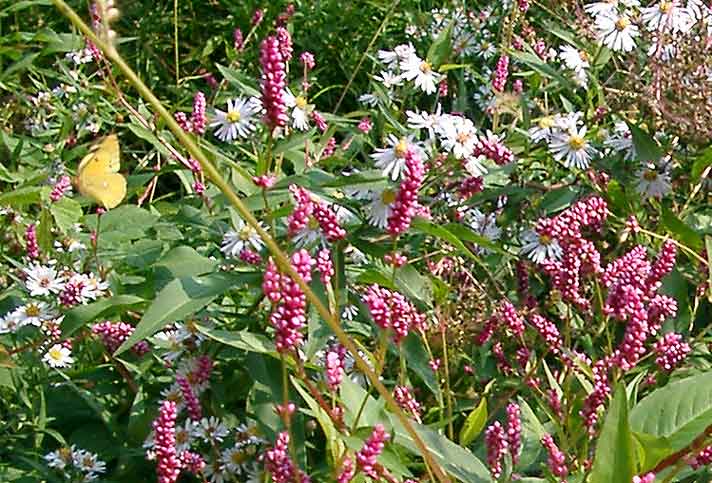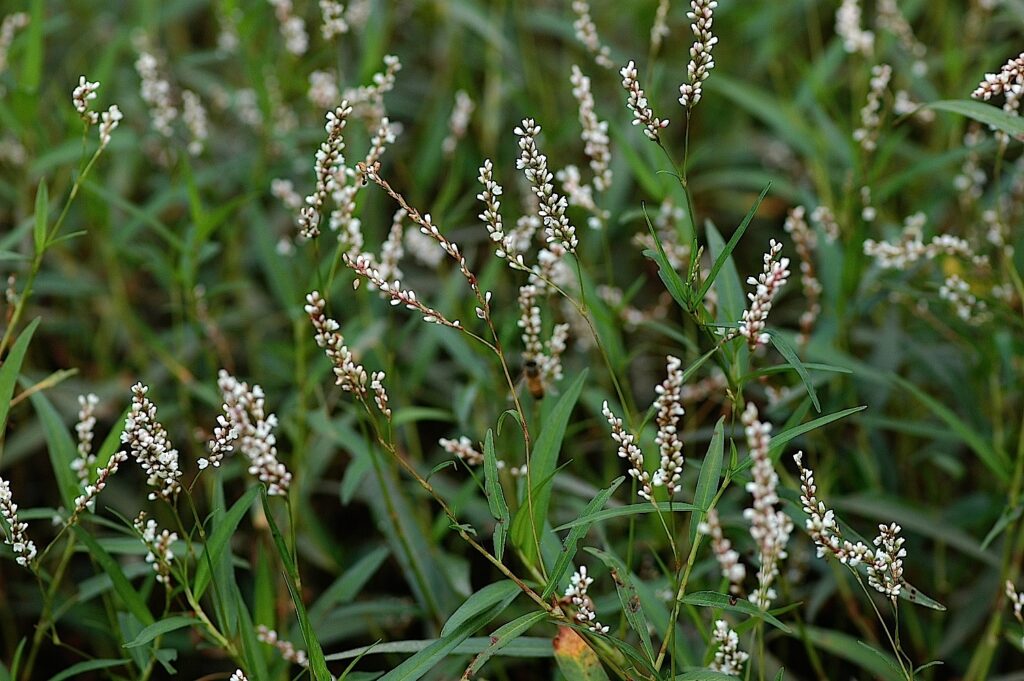Pink smartweed and white fall asters share the October sun, at the edge of a parking lot, with a yellow butterfly. Native asters make great carefree garden plants for a sunny location where their tall status (3′ or more) can be accommodated. Smartweed (polygonum) on the other hand, is horrible.
Smartweed, with the folk name “smartass”, has a behavior problem. Taken out of context, the stuff is attractive but then so are house mice and Canadian geese. However, it’s hard to be grateful for the inch of guano that the no-longer-endangered Canadian geese leave in their wake. In turn, smartweed’s not so charming when you’ve pulled it up for the fifth time this month.
See Also: The Eastern White Pines Of Hoyt Street Alley
According to the Army Corps of Engineers (even they’re watching the stuff), “There are approximately 96 taxa of Polygonum in the United States, 29 of which are not native or their native range is problematical. ” Translated into English, this means that the problem has 96 variations, foreign and domestic.

Further translated, 96 kinds means there’s some for everyone, regardless of growing zone; and it means that there are annuals, perennials, short ones (under 6″); tall ones (over 6′), pale ones, white ones, greenish ones, pink ones, spotted ones, underwater ones, and who knows what else. Smartweed is said to prefer damper sites and at least half-day sun but I find it everywhere except in the driest places. The USA Army notes that “dense colonies [of the water variety of smartweed] can impede water flow in irrigation ditches … and restrict recreational activities along shoreline areas.” That bad.
Smartweed is in the buckwheat family. Buckwheat itself is believed to have originated in China long, long ago. Unlike grains such as oats and wheat, buckwheats are not part of the grass family; they’re on their own. Buckwheat makes delicious pancakes, and the bees turn the pollen into prized honey. However, as the smartweeds go, there’s an Asian variety that’s used like cilantro, but our 96 varieties generally aren’t safe to for human consumption. Many birds, including endangered water fowl, insects, and mammals do enjoy a frequent smartweed snack. You’ll note that, in the above picture, the butterfly has chosen the smartweed over the normally delectable asters. Humans, including Europeans and Native Americans, do use the highly acidic smartweeds for internal and external medicine. In Mexico, it’s said that soaking in a smartweed bath relieves rheumatism.
Smartweed blooms from June to November, which gives it plenty of time to make lots of seeds for the birds and water to disperse. The stem joints have a knotted appearance that can lead to name confusion because smartweed’s cousin called “Japanese Knotweed” (Polygonum cuspidatum) is a menace of in its own right.
I don’t know how you get rid of the stuff. I’m not sure you can. Control might be more achievable. Like anything else, the more you pull it up and prevent it from going to seed, the better off you are. Ironically, an agro-conference on the use of “Round-Up Ready” crops (i.e immune to broadleaf herbicides) noted that repeated use of Round-Up increased the smartweed population. To me, anything that discourages use of chemicals, particularly on food that I eat, is good, so perhaps there’s a silver lining after all.

